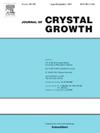Internal radiation effect on semiconductor β-Ga2O3 crystals grown by the VB Method and anisotropic thermal stress
IF 1.7
4区 材料科学
Q3 CRYSTALLOGRAPHY
引用次数: 0
Abstract
Gallium oxide crystals are semitransparent semiconductors with good optical and electrical properties, which allow their use for several technological applications. During the growth process of β- crystals, internal radiation plays a crucial role that affects the growth process and then the crystal quality. In this work, the effect of the melt and the crystal transparency on the vertical Bridgman growth of β- oxide is thoroughly studied. Using a global 2D/3D finite element model, temperature, melt flow, melt-crystal interface, and three-dimensional anisotropic thermal stress are computed at different growth stages. At each stage, four cases are considered, namely, opaque melt and crystal, semi-transparent melt and opaque crystal, semitransparent crystal and opaque melt, and finally semitransparent melt and crystal. The role of internal radiation in each case at different growth stages is then highlighted separately and then coupled together. It was found that the melt-crystal interface is shifted from a convex shape at the early stage to a nearly plane and then to a concave shape at the last stage. The melt flow is then changed from two rolls pattern at the beginning to a single-roll structure at the last stage. Thermal stress of the as-grown ingot is decreased during the growth due to the decrease of temperature non-linearities. Internal radiation inside the crystal acts to increase the melt-crystal interface convexity at the early and middle stages of the growth process and leads to a decrease in its concavity at the final stage. However, the melt transparency leads to the opposite effects, i.e., it decreases the interface convexity at the early stage and increases the interface concavity at the final stage. As a result, for semitransparent crystal and melt, the interface is between the two previous cases. The calculated thermal stresses are found to be more affected by the transparency of the crystal than the melt as the absorption coefficient of β- crystal is smaller than that of the melt. At all stages, the thermal stresses are found to be larger for the opaque case due to the increase of temperature non-linearities in the crystal. Large values are found at the bottom and the lower part of the periphery. Furthermore, internal radiation inside the melt plays a major role during the early growth stage due to the large liquid volume. It reduces the melt flow intensity close to the free surface where the shear stress is combined with the buoyant force and leads to the flattening of the interface decreasing then the radial temperature gradients, which leads to small attenuation of the thermal stress. At the final stage, the transparency of the melt plays the opposite role due to the increase of the interface concavity which leads to an increase in both of the temperature gradients and the thermal stress inside the crystal. Due to the crystal anisotropy, and especially to the large thermal expansion coefficient in the [0 1 0] direction, the 3D thermal stress values are found to be larger in this direction, especially in the bottom part of the ingot. Comparisons with available experimental and numerical works are provided in this paper.
VB 法和各向异性热应力对半导体 β-Ga2O3 晶体生长的内辐射效应
氧化镓晶体是一种半透明半导体,具有良好的光学和电学特性,可用于多种技术应用。在 β-Ga2O3 晶体的生长过程中,内部辐射起着至关重要的作用,会影响生长过程,进而影响晶体质量。本研究深入研究了熔体和晶体透明度对 β-Ga2O3 氧化物垂直布里奇曼生长的影响。利用全局二维/三维有限元模型,计算了不同生长阶段的温度、熔体流动、熔体-晶体界面和三维各向异性热应力。每个阶段都考虑了四种情况,即不透明熔体和晶体、半透明熔体和不透明晶体、半透明晶体和不透明熔体,以及最后的半透明熔体和晶体。然后分别强调了不同生长阶段内辐射在每种情况下的作用,最后将其结合在一起。研究发现,熔体-晶体界面从早期的凸形转变为近似平面,然后在最后阶段转变为凹形。熔体流动也从开始阶段的两辊模式转变为最后阶段的单辊结构。在生长过程中,由于温度非线性的降低,生长锭的热应力也随之降低。在生长过程的早期和中期,晶体内部的辐射会增加熔体-晶体界面的凸度,并导致其在最后阶段的凹度减小。然而,熔体的透明度会导致相反的效果,即在早期阶段降低界面凸度,而在最后阶段增加界面凹度。因此,对于半透明晶体和熔体,界面介于前两种情况之间。由于 β-Ga2O3 晶体的吸收系数小于熔体,因此计算得出的热应力受晶体透明度的影响大于熔体。在所有阶段,由于晶体中温度非线性的增加,不透明情况下的热应力都较大。底部和外围下部的热应力值较大。此外,由于液体体积较大,熔体内部的内部辐射在早期生长阶段发挥了重要作用。它降低了自由表面附近的熔体流动强度,在自由表面,剪切应力与浮力相结合,导致界面变平,径向温度梯度随之减小,从而导致热应力的小幅衰减。在最后阶段,由于界面凹度增加,熔体的透明度起到了相反的作用,导致晶体内部的温度梯度和热应力都增加。由于晶体的各向异性,特别是[0 1 0]方向的热膨胀系数较大,发现该方向的三维热应力值较大,尤其是在钢锭的底部。本文提供了与现有实验和数值工作的比较。
本文章由计算机程序翻译,如有差异,请以英文原文为准。
求助全文
约1分钟内获得全文
求助全文
来源期刊

Journal of Crystal Growth
化学-晶体学
CiteScore
3.60
自引率
11.10%
发文量
373
审稿时长
65 days
期刊介绍:
The journal offers a common reference and publication source for workers engaged in research on the experimental and theoretical aspects of crystal growth and its applications, e.g. in devices. Experimental and theoretical contributions are published in the following fields: theory of nucleation and growth, molecular kinetics and transport phenomena, crystallization in viscous media such as polymers and glasses; crystal growth of metals, minerals, semiconductors, superconductors, magnetics, inorganic, organic and biological substances in bulk or as thin films; molecular beam epitaxy, chemical vapor deposition, growth of III-V and II-VI and other semiconductors; characterization of single crystals by physical and chemical methods; apparatus, instrumentation and techniques for crystal growth, and purification methods; multilayer heterostructures and their characterisation with an emphasis on crystal growth and epitaxial aspects of electronic materials. A special feature of the journal is the periodic inclusion of proceedings of symposia and conferences on relevant aspects of crystal growth.
 求助内容:
求助内容: 应助结果提醒方式:
应助结果提醒方式:


